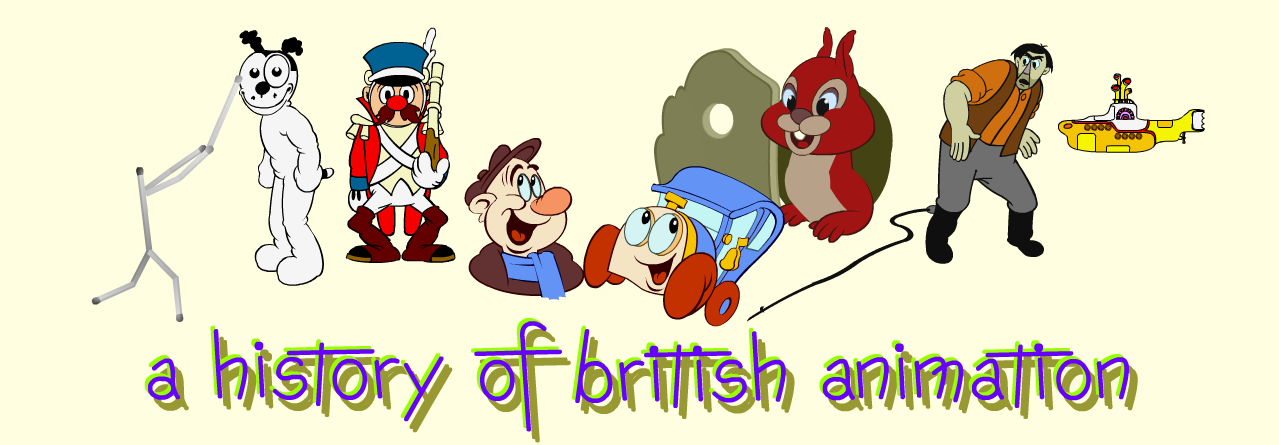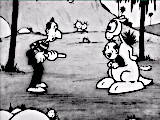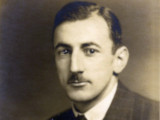

|
 | Brian White(1902-84) |  |
||
|
Hugh Brian White was born in Dunstable on 4 April 1902, the third son of builder Frank White and his wife Alice; he had two younger sisters. He was good at drawing, and as a boy during the First World War enjoyed drawing cartoons of British and German soldiers. He did not, however, take the subject seriously. A letter from his great-uncle, the artist and naturalist Worthington George Smith, commending his comic drawings and exhorting him to keep noticing things that are funny and when he needs to draw something, sketch it from life to make sure it feels real, encouraged him to persevere with his cartoons. Leaving school at sixteen Brian started work as a warehouseman at a Luton straw hat factory. He used to watch Luton football team play, and one day did a cartoon of a match which was accepted by the local paper, the Luton Reporter. He regularly contributed caricatures and sports cartoons to the local paper, and took lessons in pen drawing and watercolour portraiture from a couple of local artists. In 1924 he answered an advertisement for an assistant to draw animated cartoons, and joined William A Ward's team animating G E Studdy's Bonzo in a series of twenty-six cartoons for New Era Films, first in D'Arblay Street, off Wardour Street, and later in studios at Holland Park. In his online memoirs he says: As I could not move to London at this time, I travelled back and forth daily from home at 13, Bury Park Road, Luton on my Douglas motorcycle. I made that journey in all weathers for over a year. I had several soakíngs and not a few skids but it was great fun as I was doing what I really wanted. He also created his first cartoon strip at this time, Mr 'Enery Noodle, which ran for a while in Pearson's Weekly Magazine. When the Bonzo series came to an end Brian White stayed on in the studio in the hopes that New Era Films would back another cartoon series, but despite the popularity of Bonzo it would seem the returns, from both domestic and foreign distribution, were insufficient to warrant the company continuing with animated productions. In 1925 Pathé hired Cardiff projectionist turned animator Sid Griffiths and his co-worker Bert Bilby to make a series of cartoons for inclusion in their Pathé Pictorial magazine reel, on the strength of an animated film they had made in Cardiff, featuring a dog called Jerry the Troublesome Tyke who interacted from the drawing board with his artist, Sid Griffiths, in the manner popularised by the American Fleischer Brothers in their Out of the Inkwell shorts. Studio space was made for them in Pathé's Wardour Street offices, and with his experience on the Bonzo series Brian White was hired to assist them. Since he lists the third Jerry film, Honesty is the best policy, in his memoirs it seems likely that he assisted on most, if not all, of the more than forty films produced for the series. After the completion of the Jerry series White stayed on at Pathé to work on the Pathésong series, Pathé's "All-British" sing-along films, exploiting the popularity of community singing started by Fleischer's American Koko Song Cartunes series that Pathé were distributating in the UK. He joined Dudley Buxton who was already working on these, and it would appear that they worked on alternate titles. On the 30 January 1928 White started working at Joe Noble's studio in Hampstead, assisting on Joe's Sammy and Sausage series for Pathé's Eve's Film Review. On 5 April 1928 Brian White married Jessie Brunger, who had been the head of Pathé's Correspondence Department. For a couple of years they lived in the North St Pancras area of London. When Sammy and Sausage was complete White formed a partnership with Sid Griffiths, with the intention of making a sound cartoon series. Griffiths was making advertising films for an advertising display projection device that he had invented, and which was being manufactured by a group of Cardiff businessmen under the name of the Advertiscope. Advertising film salesman Albert Goodman became sales manager for Advertiscope Ltd, and set up a company, Super-Ads, employing Griffiths and White and several other leading animators, to provide both films for the Advertiscope (which used a banner screen format of 16:3, allowing four frames to fill the space usually occupied by one frame of 35mm film) and normal cinema commercials, the latter forming the bulk of Super-Ads' output. In his memoirs White recalls working on a commercial for Pratt's petrol where they created a coloured image of the iconic Pratt's petrol pump (an orange pump with a white dome on top) in a black and white advertisement, by filming a white pump on a black background, then painting vaseline over the dome of each of the hundred-odd frames of the scene. After dyeing the scene orange and wiping off the vaseline they had a good image of an orange and white pumo which was then spliced onto the rest of the film. He does not mention if they did this for more than one print. He also recalls a cartoon film based on the song Tiptoe through the Tulips for the Jack Hylton band, to be shown on stage during their performance. Although White asserts he and Griffiths worked without any assistants, Danish artist Jørgen Myller, employed by Super-Ads as a designer, recalls designing and directing this film, and learning to animate from Griffiths. Goodman also set up another company, Comedy Cartoon Sound Film Company Ltd (CCSF Co) to accommodate Griffiths and White's series ambition, producing Tropical Breezes, a cartoon featuring two human characters, one tall, one short, based on caricatures of the two animators. When the News of the World came to do a story promoting the production, they discovered that Griffiths and White had not settled on names for the duo, and helpfully organised a readers' competition, published 29 June 1930: The two quaint individuals sketched above will, in the very near future, make their bow to British screen audiences in a new and amusing cartoon comedy sound film series, which bids fair to outshine all foreign rivals. They have been created by the pens of two clever British black-and-white artists, Messrs. Griffiths and White, and their adventures are now being recorded at the Welwyn Film Studios. The winning names were "Hite and Mite". Unfortunately, the failure of the Advertiscope led to an inability to continue financing Goodman's other companies, and Super-Ads and CCSFC went into liquidation. In the Autumn of 1931 Brian and Jessie moved to Enfield, where on 1 October their son John was born. In 1932 Raycol British Productions Ltd, manufacturers of the Raycol colour film process backed by film director Maurice Elvey, approached cartoonist H M Bateman, who had contributed to a couple of silent animated commercials made by Adlets Ltd in 1924, with the idea of producing a series of animated cartoons to promote the colour system. Bateman supplied the story for the first film, On the Farm, in the form of a series of key drawings and Griffiths and White took on the animation, joined later by Joe Noble. While working on On the Farm White developed another strip cartoon character, Jinky, which ran in the weekly Pearsons Magazine during 1931 and 1932. On the Farm was followed by a second Bateman cartoon, Colonel Capers, but there seems to be no record of this being released. Brian's son John, now a toddler, provided Brian with a new source of humorous situations, and inspired him to create a new comic strip character, Nipper, which became a daily feature in the Daily Mail from 30 August 1933. No further H M Bateman cartoons were made. Instead Brian White started work on Treasure Island, the first of a proposed series of Barnacle Bill cartoons for Raycol (Griffiths and White had ended their partnership, and Griffiths left to work for British Utility Films). The Kinematograph Weekly reviewed the film on 1 February 1934: A.B.F.D. The Raycol process was a commercial failure. No further Barnacle Bill cartoons were made, and Brian White gave up animation to concentrate on his Nipper strip for the Daily Mail. The strip was very popular, and spread to various merchandising in 1935 and an Annual in 1936. White was able to move the family to Worthing in 1937. During the War the restrictions on newsprint meant that the Nipper strip appeared less and less frequently in the Daily Mail as space became a premium. White found extra work on the children's comic Knockout, taking over Deed-A-Day Danny from Hugh McNeill, and then creating his own strip, Little Tough Guy. The last of the Daily Mail's Nipper annuals was published in November 1942. In March 1942 White was called up to the Police War Reserve, initially in Liverpool, then transferred to Luton. Discharged in November 1945 he was able to return to supplying the Nipper strips for the Mail. Further Nipper spin-offs included reprints of Nipper strips in painting book form (making a virtue of their lack of colour!), a road safety booklet called Careful Nippers, and Nipper's AZ Animal Book. He also designed the board for a snakes-and-ladders style game produced by Spears Games under the name Nipper's Ups and Downs. The newspaper strip ended its run in 1947. The Whites' daughter, Susan, was born in late 1945. With his cousin Harold, Brian formed a publishing company, B & H White Publications Ltd, with an office at 23 Fleet Street, most noted for publishing F. E. Loewenstein's photographic collection Bernard Shaw through the Camera in 1948. In 1951 Brian White provided a series of Nipper cartoon panels for Pathé, who released them as 35mm film strips for use with the toy slide projectors and hand-held viewers that had become popular. The only one I have found reference to is Nipper At The Fun Fair, which consists of 23 individual cartoons. These are on black and white film, with some tonal shading (the example online had had some touches of hand tinting applied by its owner). Some sources assert that White returned to animation to work on Halas and Batchelor's Animal Farm, but I can find no verified evidence that this is so, and it is of note that it does not appear in his memoirs. I think, therefore, that this is an error that has spread across the internet through unverified repetition. In 1953 American cartoonist Bill McLean ended his daily strip Double Trouble, about a pair of twins (based on his own children), after 9 years of syndication by King Features. It had been picked up by the London evening newspaper The Star, and their run came to an end in 1955. A London agent bought the strip and Brian White was put under contract to continue it as a British strip, which carried on running in The Star. In 1960 The Star was merged into The Evening News where the strip continued for another seven years. White also worked for D C Thomson's comics, standing in for other artists on Keyhole Kate in Sparky, and drawing Shorty in The Beezer (1956), Tich and Snitch in Buzz (1973), and Plum Duffy in Topper (1974). Jessie White died on 12 September 1974. Brian White died in Rustington, West Sussex, on 4 November 1984.
|
Filmography | ||||
| Bonzo (series of 26 cartoons) | (New Era Films 1924-5) Member of animation team | |||
| Jerry the Troublesome Tyke (series of 40+ cartoons) | (Pathé 1925-7) Assistant Animator | |||
| There's a Long, Long Trail A-Winding (Pathésong series) | (Pathé 1926) Animator | |||
| Land of Hope and Glory (Pathésong series) | (Pathé 1926) Animator | |||
| Sammy and Sausage (series of 19+ cartoons) | (Pathé 1928-9) Assistant Animator | |||
| Tiptoe Through the Tulips (for Jack Hylton) | (Super-Ads c.1929) Animator | |||
| Pratt's Petrol (advertising film) | (Super-Ads c.1929) Animator | |||
| Tropical Breezes | (CCSF Co. 1930) Co-Producer, Co-Director, Animator | |||
| On the Farm | (Raycol British 1932) Animator | |||
| Colonel Capers | (Raycol British, not released) Animator | |||
| Treasure Island | (Raycol British, 1934) Director, Animator | |||
Links to Other Sites | ||||
BRIAN WHITE ARCHIVE: 16 pages of autobiography, artwork, etc |
Peter Hale
Last updated 2025
|